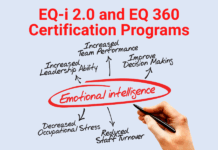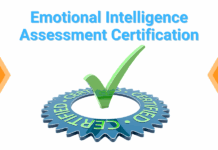
Dr. Brit Poulson is an expert on human growth potential, the founder of Clarity Consulting, and the author of The Clarity Compass: See More Clearly. Have Creative Conversations. Live the Life you Want.
In an exclusive webinar for LEADx subscribers, Poulson taught how to discover your blind spots, move through them, and broaden your perspective so you can be freer, happier, and more effective. The following transcript has been lightly edited for length and clarity.
Brit Poulson: “Welcome to Embracing Uncertainty. I'm excited about today's talk because to me it really is an invitation to possibility, imagination, and creating a whole new life either entirely or in specific areas. But, to do that, we have to be willing to embrace uncertainty.
The clarity compass. This a tool that I created because I just found the world overwhelming. It was too much for me. It was too chaotic. I thought, I just need to find a way to organize the world better. This tool has come in handy for me and many of my clients, because the world is continuing to get more chaotic and more ambiguous. There's just more and more information out there to manage.
The basics of the tool. You start off with your intention. Getting really clear on what your intention is. What do I want? How do I create that vision of the outcome I want? The clearer you can be on your intention, the more focused you are on your actions and creating more and more specific actions, making requests, so forth.
But, the main idea is to first get clear on your intentions and then have that flow naturally into the actions and activities that you do every day.
Facts versus stories. Again, there's all this information coming at us, and we tend to make up a lot of stories about the world. Separating out that this is an observable fact versus this is a story that I'm making up, or an internal experience that I'm having, is another way to kind of ground into fact and get clear on my stories.
We're going to see how this model works with a case study. The things that I'm inviting you to take away today is first getting even clearer on how, as a human being, I'm clinging to certainty. It's just a part of the human being, I'm just naturally gravitating toward. I just want to be certain, I want to be certain, I want to be certain.
Some of that certainty is coming from what I'm calling reality maps. I don't actually see the world as it is, I experience the world based on my version of it. That's what I call a reality map. Most of us operate from a place of like I know what's going on, I have a sense of reality, I'm looking around, I know reality. But, one of the things that helps to have a little bit of uncertainty, be present with uncertainty, is that maybe my reality maps aren't 100% accurate. Maybe some of the challenges that I'm having come from the lack of accuracy in my reality maps. I think I'm dealing with reality, but actually I'm dealing with an incorrect reality map.
The last piece here is that as I become more aware of my blind spots and they are no longer blind spots, then I'm dealing with reality more on its own terms. I can do that by embracing uncertainty. There's an aspect of imagination that we're talking about here that I can step further into.
Briefly, my story around this is that when I was young, I was actually an accounting major. I did that because assets equal liabilities plus capital, and debits equal credits, and I wanted certainty. I wanted control in my life. Just to be a little bit personal, I was at a sales conference. I took a job one summer selling books door-to-door and I was at a sales conference. I walked by a guys door and I heard him say, he was reading from Og Mandino's book, The Greatest Salesman in The World. He was reading, “I am not a sheep, I am a lion.” For some reason it just impacted me in a way that I started to think, wow, I can learn things, I can be smarter, I can get more information, I can learn some skills. But that metaphor of being a lion versus a sheep just kind of struck me that I can show up differently. I can have a different disposition. I can have a whole different orientation to the world.
Because if I'm processing the world, if my reality map is that I'm a sheep, I'm going to process the whole world differently than if I've got the heart, courage, and strength of a lion. If I see myself differently, I'm going to orient differently to the world. That's what this talk is about, is if I'm certain on one thing that's limiting myself from being something else that might be a better possibility for me.
This is the work I do every day with clients to help open them up to new ways of being effective and happier. That's my hope for you.
Being overly certain. Think of a time when you were certain about what someone else was thinking or why they were acting in a certain way. Then, later you were wrong. To be thinking, “Uh-oh, I was so certain about that.” Again, this talk isn't about NOT being confident. Because I do think there's a place and importance in terms of marching forward with confidence.
But, if I'm marching forward with confidence, there's also another part of me that’s thinking, “okay, where might I be overly certain?” It's a balance between keeping my confidence and finding the places where I might be overly certain and it's harmful.
Certainty can block possibility. Not all the time, but that's what we're trying to discover. Where is it blocking possibility? I like this quote, “The quest for certainty blocks the search for meaning. Uncertainty is the very condition to impel man to unfold his powers.” Or, her powers. I like that quote. Einstein has a similar quote, “Imagination is more important than knowledge.”
Rather than be fixed on knowledge, how can you imagine new possibilities for yourself and others?
Case study using the clarity compass. Put yourself in Erwin’s shoes. Remember, intentions to actions, facts to stories, facts versus stories. That's what Erwin did. Erwin said, “Okay, I have a situation I want to work with, I'm going to use the clarity compass.”
- Intentions: I want to be recognized as a leader by my boss, Bill.
- Actions: Follow Bill’s direction so that my leadership is consistent with what he wants.
- Facts: My manager created outlines for 7 out of 8 of my last proposals.
- Stories: If I don’t do projects exactly the way Bill wants me to, he’ll see it as a failure on my part.
Now Erwin (and you since you are in his shoes) should put himself in Bill’s shoes to get his perspective. I call it empathetic guessing. If you're doing this and you're thinking well I'm the best and I'm right and everybody else is wrong, then you're probably not stepping in their shoes fully. There's usually some reasonable explanation for the things people are doing. If you can access that, then it gives you more access to how they're thinking and how they might be able to think differently and engage differently with you.
So Erwin might think Bill is thinking:
- Intentions: I am helping Erwin out by giving him detailed instructions.
- Actions: I spend time with Erwin, instructing him so that I can make sure he is successful.
- Facts: I assign projects to Erwin with suggestions for all of the categories to set Erwin up for success.
- Stories: By closely coaching folks, I create winners.
As Erwin stepping into Bill's shoes as best he can, he's thinking that Bill is helping his employees out. Just doing the clarity compass this far helps Erwin get some access. Rather than just think he's controlling, it's like, “okay, he's got some good intentions, he's trying to help out.” It gives an access to Bill that is not accusatory but actually a place to begin to start some conversations with. Erwin, in trying to step into Bill's shoes, is trying to create some type of understanding from which he can have a better conversation.
More on reality maps. The definition is our internal representation of the external world. Here’s the world out here, and I have some representation of it inside me. It's not a 1:1 correlation, it's just my best guess. We always operate from a limited amount of information, and a key piece here is that the world is too complex for our minds to comprehend. There's a little bit of humility in today's exercise.
The idea is the world is way too complex. I can't manage all this complexity at some level in our brains. We develop rules of thumb to try to understand and manage and navigate the world.
Begin to realize that your reality map, your best guess at reality, is limited.
3 Keys To Understand Reality Maps:
- We all have them.
- We can't navigate the world without them. It is our way of figuring out who's doing what.
- Without them, our brains would continually be on information overload. They take the complex world and make sure we're not overloaded, because if we were trying to take in everything fully it would be too much and we'd just be immobilized.
The reality maps are necessary and helpful but limited. One, our brains just can't hold all the information and figure it out. Two each person’s experience is different. We all have different experiences, so again our reality maps are going to be different. To some degree that adds diversity and makes it interesting, but it also can create conflict, because our reality maps aren't literal or accurate of the world. We don't always make the best decisions.
Back to the case study. So what does Erwin’s reality map look like? He wants to show up, he wants to lead, he wants to be recognized, but in the end he's just able to just kind of do what he's told. That's the reality that he's living in.
What about Bill’s reality?
- Intentions: To be able to trust that Erwin can handle a project without my input.
- Actions: Ask Erwin to take the initiative and offer his ideas for future projects
- Facts: Erwin follows 99.9% of instructions/outlines that I give him. Erwin doesn’t take action until I’ve given instruction.
- Stories: Erwin is extremely eager to have my detailed instructions and feels anxious as if I am neglecting him if I don’t provide him guidance and encouragement.
What he’s learned from looking at the facts is that Erwin needs a lot of attention and direction, and if he doesn't get it, then he's going to be upset. But, just as Erwin stepped into his, Bill wants to step into Erwin's shoes. So Bill might think Erwin is thinking:
- Intentions: I want to be a star performer in the company
- Actions: I need to take advantage of listening to Bill’s instructions when he provides good teaching moments.
- Facts: I deliver my projects on time to the specifications that Bill gives me 100% of the time. I follow directions well.
- Stories: I can tell Bill really values me because he invests time in teaching and instructing me.
You can see the two reality maps. They're completely different realities and there might be some conflict. Erwin's getting frustrated because he's being micromanaged by Bill. And Bill's getting frustrated because Erwin's not taking initiative.
If you look through your day and look closely enough, you'll see these same kind of miss-matches of reality maps all the time.
Bill is certain of these things, and Erwin is certain as well. That certainty is creating greater conflict.
Understanding why the conflict is there with reality maps. Basically, we have simple basic assumptions. Most of them are unconscious. We're not analyzing every one of our assumptions that create our reality. Those assumptions help us to function moment-to-moment. They're so embedded and usually they cross reference each other. Usually, our reality maps are pretty internally consistent, otherwise there’s cognitive dissonance. So changing means a major reorganization of thinking. Because of that, the change is often emotionally disturbing. We want to minimize that cognitive dissonance. New information comes, our first impulse is that's it’s not fitting with our reality maps so we typically reject it.
Coming back to Erwin and Bill. They had a conversation and got clearer on how the other person was thinking. They went back to their compasses.
Erwin corrects his compass “as Bill.”
- Intentions: I give Erwin extra guidance because he wants me to.
- Actions: I spend time with Erwin because it shows that I am really invested in his success.
- Facts: I give extra detail to Erwin because he needs and wants this extra input.
- Stories: Erwin really wants this extra guidance, if I didn’t do this, he wouldn’t know how much I believe in his potential.
All this is to say that Erwin went from the original “Bill is 100% controlling” to “okay, he thinks micromanaging is helpful” to “actually he's trying to be helpful particularly to me.” Again, you can see Erwin's reality map slowly changing from the place of certainty where it's 100% control, to there's some other things going on here. Each of these steps bring Erwin and Bill closer together rather than adversarial.
Similarly, after the conversation, Bill goes back to his clarity compass “as Erwin.”
- Intentions: I want Bill to believe that I can take initiative.
- Actions: I want to be invited to offer my ideas on current and future projects.
- Facts: We have no process in place for me to offer my ideas to the management team on a regular basis.
- Stories: I am interested in stepping up and taking a project from start to finish with minimal input from Bill.
This is a huge turnaround for Bill, who was thinking that Erwin wasn't interested in it. You can see both of their clarity compass, their reality maps, are coming closer and closer together, and seeing the other person more clearly rather than being deeply entrenched in their original perspective.
You can see in this case study that the reality maps cause us to have blind spots. You can see Erwin and Bill each had ways of seeing that were just not inclusive of the perspective of the other person. Through the conversation, they opened up and filled in some of those blind spots.
The clarity compass is a tool to help us manage and leverage uncertainty and become conscious to our blind spots. Intentions to actions, facts versus stories. We can use it in breakthroughs in relationships, professional as well as personal.
But also, just even within ourselves, how do I sort out what my intentions are? What are the actions I need to take if those are my real intentions? How do I start breaking out facts versus stories?
For those of you who are interested in a worksheet, click here. It's a little more complex, but it gives sub categories to the compass.
Imagination. There’s something freeing about letting go of our certainty about how we are, how others are. There's a rigidity that each of us have that's a part of our reality maps, it's like the air we're breathing. The fish not knowing that it's in water. It doesn't pay attention to these things. There's a rigidity that each of us has that locks us up and confines our imagination. I'm kind of being depressing in this in terms of saying if you wanted to have imagination, you have to really realize how rigid and certain we are. I apologize for that.
At the same time, I'm excited because as we realize some of our rigidity, we can let go of it and it frees up our mind to have new possibilities for our lives and for our engagement with other people.
As you begin to let go of certainty and allow your imagination to open up, and open up to new possibilities, there can be ways that your life changes that are currently unimaginable.
That's the essence of this time together: embracing the uncertainty and opening up to new possibilities for your life.
Feel free to reach out with any questions, comments, feedback to me. I like to try to be open to my own certainties that I can open up to. Thank you again, and I hope you've enjoyed this, and more importantly find it useful.”















